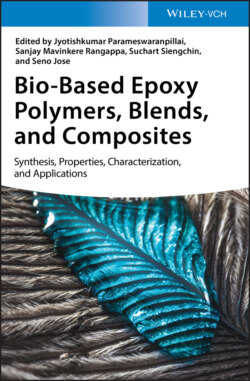Читать книгу Bio-Based Epoxy Polymers, Blends, and Composites - Группа авторов - Страница 3
List of Tables
Оглавление1 Chapter 1Table 1.1 The content of various fatty acids in selected vegetable oils.Table 1.2 Proportions of interunit linkages in softwood and hardwood 50.Table 1.3 Thermal analysis data for epoxy resin blends containing DGEBA and c...Table 1.4 Thermal decomposition of BPA‐based epoxy resin and the DGEBA/lignin...Table 1.5 Thermal and mechanical properties of PTCP, neat epoxy, and EP/PTCP ...Table 1.6 TGA,Tg, and Td values of epoxy resin samples cured with different c...Table 1.7 Properties of epoxy resin networks cured with bio‐based curing agen...
2 Chapter 2Table 2.1 Some commercial aramid fibers [9].Table 2.2 Typical melting temperature ranges of PE [17-19].Table 2.3 Composition ranges (%) and applications for commercial glass fibers...Table 2.4 Compiled properties and chemical compositions of natural fibers [56...Table 2.5 Mechanical and physical properties of two types of silk fibers [79,...Table 2.6 Mechanical and physical properties of basalt fiber [92].Table 2.7 Price of several fibers [95].Table 2.8 Mechanical properties of epoxidized natural oil.Table 2.9 Comparison of the bio‐based DGEI with the petroleum‐based DGEBA wit...Table 2.10 Comparison of Epidian 5 DGEBA and isosorbide‐based epoxy with four...Table 2.11 Tensile and fracture properties of furan‐based epoxy compared with...Table 2.12 Flexural strength of polyphenolic epoxy compared with DGEBA [115].Table 2.13 Comparison of mechanical propertie of polyphenolic epoxy and DGEBA...Table 2.14 Impact properties of ENR‐modified DGEBA [118].Table 2.15 Thermal properties of epoxidized lignin and DEGBA [121].Table 2.16 Tensile properties of vanillin‐derived epoxy [122].Table 2.17 Flexural properties of DGEDVCP [123].Table 2.18 Flexural and impact properties of rosin‐based resin [125–128].Table 2.19 Tensile properties of bioepoxy with different ratios of FPR and EG...Table 2.20 Mechanical properties of glass fiber‐reinforced CSE‐modified epoxy...Table 2.21 Tensile properties of carbon and glass fiber‐reinforced bioepoxy [...Table 2.22 Mechanical properties of flax fiber‐reinforced flaxseed oil based ...Table 2.23 Comparison of hemp, ramie, and flax for cardanol‐modified epoxy [1...
3 Chapter 3Table 3.1 The fatty acid distribution of numerous common plant oils [34].
4 Chapter 4Table 4.1 List of cross‐linkers used to cure bio‐thermosets.Table 4.2 Literature summary on curing kinetics of bio‐epoxy and blends.Table 4.3 The kinetic parameters of the curing systems by non‐isothermal meth...
5 Chapter 5Table 5.1 Gel time data for the reactive systems DGEBA/IPD, DGEDASn/IPD, and ...Table 5.2 Epoxy resins produced from rosin.Table 5.3 Gel time data of the hybrid resins at various temperatures (mean da...
6 Chapter 7Table 7.1 Mechanical properties of bioepoxy polymers.Table 7.2 Tensile and flexural properties of bioepoxy blend systems.Table 7.3 Tensile strength and modulus properties of bioepoxy‐based composite...Table 7.4 Mechanical properties of bioepoxy‐based nanocomposites.Table 7.5 The improvements attained on the properties of bioepoxy‐based nanoc...
7 Chapter 8Table 8.1 Electrical and electronic properties, method of epoxy casting techn...Table 8.2 Electrical systems, method of epoxy casting technique, and methodol...
8 Chapter 9Table 9.1 Typical bands in the IR spectra.Table 9.2 Sample of electronegativity effects and chemical shift.
9 Chapter 10Table 10.1 The oxygen index of representative plastics.Table 10.2 UL‐94 rating.Table 10.3 CFT factors with variation of polymer molecular structures.
10 Chapter 12Table 12.1 Detailed data from microcombustion calorimetry of the PSA.
